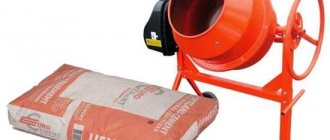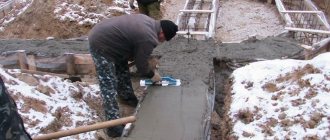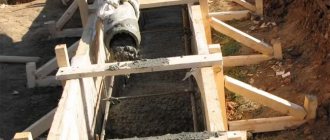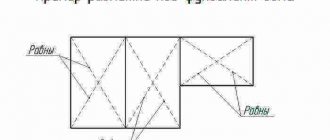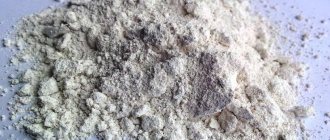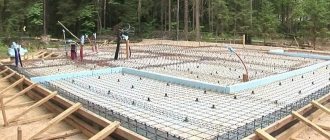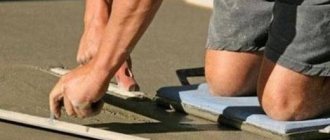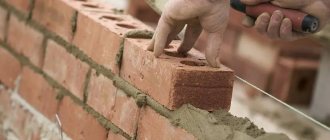Cement is a unique building material, without which small or large-scale construction is impossible. In addition, cement is an expensive and “perishable” material. Therefore, all private developers are interested in the optimal option for purchasing bags of cement for preparing concrete for a particular construction.
At the same time, taking into account that the generally accepted measure of ready-mixed concrete is “cubic meter”, it is important for private developers to know how many bags of cement are in a cube of general construction heavy concrete or general construction mortar of “common” brands. Let's consider this problem for bags of cement of different weights, as well as concrete and mortars of “common” brands.
Filling materials: sand and granite
Universal auxiliary components, interacting with cement, make it possible to obtain a durable building. Regardless of the brand and type of dry product, the composition of the concrete mass includes:
- crushed stone is a durable frost-resistant stone without harmful impurities and components. To increase the hardness of the concrete mixture, granite is used, with fractions from 10 to 40 mm. Good performance properties determine the high cost and popularity of the building material.
- Sand is a sedimentary solid. A correctly selected brand of sand helps reduce the consumption of expensive limestone. For foundations, alluvial quarry sand of medium grain size from 1.2 mm to 3.5 mm is in demand. The permissible amount of impurities should not exceed 5% of the total volume of sand.
Water is added to the solution in portions until a mixture of homogeneous consistency is obtained. When mixing the constituent elements, be sure to correctly determine their proportions. The resulting voids between grains of gravel if filled incorrectly will subject the base to rapid deformation.
How to calculate cement for a foundation
The method for calculating the required amount of cement is quite simple. The main role, naturally, is given to concrete, which is planned to be obtained from this building material. Having studied the proportions of concrete for the foundation, it is easy to calculate how much cement will be needed to build the foundation of the house. Calculations are usually carried out in bags that can contain kg of binder.
Approximately how much cement will be needed to build a foundation?
The calculation sequence can be presented as follows, step by step:
- First, we calculate the volume of concrete that will be used to build the foundation. We wrote how to do this in the article “Calculation of concrete for a foundation.” At this stage, it all comes down to summing up the volumes of individual foundation structures, or the usual volume calculation, which is important for a slab foundation;
- Next, we determine the composition of the concrete mass. Depending on the loads on the sub-foundation of the house, as well as the composition of the soil, the grade of concrete is determined. The percentage of cement per unit volume (usually calculated per cubic meter) depends on the brand of concrete mixture. At the same time, an analysis is carried out to determine whether it is necessary to introduce various additives into concrete to simplify the work under specific conditions;
- at the last stage, the required amount of binder and fillers (sand, crushed stone, etc.) is calculated. We will talk about what kind of sand is needed for the foundation in one of the following articles.
Below we have presented a table, using which you can calculate the approximate number of bags of cement per concrete for the foundation. Minor adjustments are possible both up and down. If you plan to strengthen the foundations with cementation (we are mostly talking about restoring the old foundation, when a new one is additionally attached to it), then, accordingly, the volume of required cement must be adjusted to the cement mortar, and not the concrete mixture.
Design grade of concrete Brand of cement used Approximate mass of cement per 1 cubic meter. m of concrete Number of bags 50 kg per 1 cubic meter m. concrete, pcs.
| M150 | M300 | 260 | 5,2 |
| M200 | M300 | 290 | 5,8 |
| M400 | 250 | 5 | |
| M500 | 220 | 5,4 | |
| M250 | M300 | 340 | 6,8 |
| M400 | 300 | 6 | |
| M500 | 250 | 5 | |
| M300 | M400 | 350 | 7 |
| M500 | 300 | 6 | |
| M400 | M400 | 400 | 8 |
| M500 | 330 | 6,6 |
It turns out that calculating the volume of cement for the foundation is not particularly difficult
It is only important to know the volume of concrete required for the construction of a specific type of house foundation, as well as the ratio of the components included in the concrete mixture
Price of cement packaged in bags and big bags
| Cement brand | Unit price | Manufacturing company | ||
| Bag 40 kg, rubles | Bag 50 kg, rubles | Big bag weighing 1 ton, rubles | ||
| M400 | 205 (5125 per ton) | 240 (480 per 1 ton) | 4 500 | CJSC "Construction Materials" |
| M500 | 225(5625 per ton) | 265 (530 per 1 ton) | 4 800 | OJSC Novotroitsky Center Factory" |
Approximate tabular data
The approximate consumption of cement per cube of concrete for the foundation, depending on the brand used, is presented in the tables:
mixture prepared on the basis of M300
| Concrete grade | M250 | M300 |
| Required mass of cement, kg | 340 | 300 |
based on M400
| Concrete grade | M300 | M400 |
| Required mass of cement, kg | 350 | 300 |
When the amount of cement of a particular brand in the composition changes, the brand of concrete changes. The values indicated in the table depend on the quality of the soil and the size of the crushed stone material, and therefore may change up or down during calculations.
Does it make sense to use M500 for the foundation?
Using the arithmetic method or tables, it is not difficult to find out, for example, how much M 500 cement is needed per 1 cubic meter of concrete for the foundation. At least 8 bags or 400 kg to obtain M400 mortar, used for the construction of foundations in professional construction.
Using M500 in small construction does not make sense
It is not advisable for 1 cubic meter of concrete to contain more than 350 kg of cement. An oversaturated foundation will be subject to severe cracking after the final evaporation of moisture. Therefore, it is not advisable to use the M500 grade for placing concrete under the foundation. This material is intended for other purposes.
Price of 1 ton of cement of different brands in bulk
| Cement brand | Price for 1 ton, rub. | |||
| CJSC "Construction Materials" | JSC "Eurocement" | OJSC "MTsOZ", Magnitogorsk | OJSC Novotroitsky Center Factory" | |
| M300 | 3 550 | — | 3 550 | 3 550 |
| M400 | 4 050 | 4 050 | 4 050 | 4 050 |
| M400 | — | 4 100 | — | — |
| M500 | 4 200 | — | 4 200 | 4 200 |
As follows from the table data, different manufacturers try to monitor competitors’ prices and keep them at a certain level, and the cost of 1 ton of cement increases depending on the decrease in packaging capacity and decreases in the absence of it - cement “in bulk”.
Source
Materials calculation: without reinventing the wheel
How to calculate cement for the foundation? For the accuracy of the results, it is necessary to take into account the grades of concrete and cement, as well as the ratio of water and cement, which is called briefly - VC. The table below is visual and does not require a person to have a degree in mathematics.
The table is easy to use. For example, we need to prepare 2 m3 of M250 concrete:
- It requires M500 cement, which means we multiply 297 kg by 2 and get 594 kg. Now this number must be divided by 50, since this is the weight of one bag of cement: 594/50 = 11.88. We round the result towards a larger value - we get 12 bags of M500 cement.
- Crushed stone with a grain size of 20 mm for our concrete will be calculated as follows: 1188 multiplied by 2, we get 2376 kg. If you choose a different faction, then all calculations will have to be done again.
- Sand is calculated in the same way as crushed stone: 1188 * 2 = 2376 kg.
- We find water like this: multiply 205 liters by 2, resulting in 410 liters.
Indeed, calculations should not cause difficulties; you just need to decide on the required characteristics of your raw materials. If plasticizers are used for the foundation, then adjustments must be made to the calculations; the coefficients can easily be found in reference books.
Calculation of cement per 1 cubic meter of concrete (m³)
The proportional ratio of cement to other binding materials affects the mobility of the concrete mixture. In order to prepare high-quality building materials, the following ratios should be adhered to:
- cement up to 1 kg;
- sand up to 3 kg;
- crushed stone up to 5 kg.
Failure to comply with all component ratios leads to a decrease in the strength characteristics of the future building coating. This will lead to rapid wear and cracking of the surface. The quantitative consumption of cement per 1 m³ of solution directly depends on the brand of concrete mixture planned by the manufacturer. Under different climatic conditions and construction zones, different grades of material are used.
Concrete marking classifier
Table of the ratio of classes and grades of concrete.
For various requirements for the stability and reliability of a construction project, the following marking classifier of concrete mixtures is mainly used:
- M100. It is used at the initial (preparatory) stage of construction work.
- M200. Has a wider range of applications. Most often used when filling foundation surfaces.
- M300. This building material has great strength characteristics. The foundation laying with such a concrete monolith is used in industrial construction.
- M400. It is used in the construction of hydraulic structures. It has high strength and differs from other types of concrete by its rapid hardening.
Decoding of the building material: the letter M with a number that indicates the arithmetic mean value of the strength characteristics of the sample, for compression in kgf/cm².
How many cubes of concrete are needed for the foundation?
When constructing a civil or industrial facility, two types of foundation coverings are used: strip and slab foundations. For the convenience of calculation indicators, a reinforced concrete (reinforced concrete) foundation of 10 by 10 is taken:
- Strip foundation. The required amount of construction mixture is determined by the total volume of the base. The calculation is carried out by multiplying metric values: height, length and width of reinforced concrete tape. Initial data: height - 1.5 m, width - 0.5 m, total length of the tape - 55 m. Multiplying the values and rounding the value to a whole number, we get 41 cubic meters of concrete.
- Slab base. The amount of concrete mixture is determined very simply for a slab foundation. For example, the thickness of the slab is 40 cm. Multiplying the initial data, we get: 10 m x 10 m x 0.4 m = 40 m³.
Weight of 1 m³ of concrete mixture
The specific gravity of the binding building material is a variable value.
The mass of concrete weighs differently, depending on its structural components, that is, on the type of aggregate. In civil and industrial construction, a heavy type of concrete monolith is usually used. Gravel and crushed stone of large fractions are used as filler. Thanks to this base, the foundation coating has a particularly durable and stable surface. The weight of one cubic meter of concrete mixture ranges from 1.7 to 2.5 tons.
We determine how much cement, sand, crushed stone and water are in a cube of concrete.
4 June, 2013 - 12:35 Concrete is one of the most popular materials in construction. Such popularity of concrete is explained by its excellent properties: compressive strength, ease of molding and laying, waterproofness, water resistance, and low price.
To make concrete, cement, water and so-called aggregates are used, which can be large (crushed stone) or small (sand). Builders often face the question of how to mix concrete correctly. It is at this stage that you usually need to decide how much cement is in a cube of concrete.
Today, there are a large number of grades of concrete that differ in their composition, or more precisely, in the volumetric or mass ratio of the components included in its composition. For example, to create 1 cubic meter of concrete grade 100 requires 200 kg of cement, to create 1 cubic meter of concrete grade 400 requires 360 kg of cement.
There are special tables from which you can understand not only how much cement per cube of concrete is required, but also the percentage of other concrete components in the finished composition.
So, for example, for the most popular concrete grade 300, it is necessary to mix 382 kg of M400 cement, 705 kg of sand, 1080 kg of crushed stone and 220 liters of water. For grade 100 concrete you will need 214 kg of cement (M400), 870 kg of sand, 1080 kg of crushed stone and 210 liters of water.
In general terms, you can determine how much sand is in a cube of concrete using the following scheme:
For 1 volume fraction of cement in concrete grade 100 there are 4.1 fractions of sand and 6.1 fractions of crushed stone; for concrete grade 150, the ratio of cement (M400), sand and crushed stone is 1 to 3.2 and to 5.0; for concrete M200 - 1 to 2.5 and to 4.2; for M250 – 1 to 1.9 and to 3.4 (cement: sand: crushed stone); for 300 1 to 1.7 and to 3,”; for 340 1 to 1.1 and to 2.4.
Table 1. Proportions of cement, sand and crushed stone by concrete grade
| Concrete grade | proportions cement: sand: crushed stone | |
| cement grade 400 | cement grade 500 | |
| 100 | 1,0 : 4,1 : 6,1 | 1,0 : 5,3 : 7,1 |
| 150 | 1,0 : 3,2 : 5,0 | 1,0 : 4,0 : 5,8 |
| 200 | 1,0 : 2,5 : 4,2 | 1,0 : 3,2 : 4,9 |
| 250 | 1,0 : 1,9 : 3,4 | 1,0 : 2,4 : 3,9 |
| 300 | 1,0 : 1,7 : 3,2 | 1,0 : 2,2 : 3,7 |
| 400 | 1,0 : 1,1 : 2,4 | 1,0 : 1,4 : 2,8 |
| 450 | 1,0 : 1,0 : 2,2 | 1,0 : 1,2 : 2,5 |
Knowing these proportions, you can not only easily find out, for example, how much crushed stone is in a cube of concrete, but also mix absolutely any amount of high-quality concrete without much difficulty.
Table 2. Relationships between classes and grades of concrete by strength.
| Brand | Class | Strength, kg/cm2 |
| M-100 | B7.5 | 98,2 |
| M-150 | AT 10 | 131,0 |
| M-150 | B12.5 | 163,7 |
| M-200 | B15 | 196,5 |
| M-250 | B20 | 261,9 |
| M-350 | B25 | 327,4 |
| M-400 | B30 | 392,9 |
| M-450 | B35 | 458,4 |
| M-500 | B40 | 532,9 |
It is important to note that the grade of cement used to make concrete will determine its physical and mechanical properties. So, if instead of M400 cement you add M500 cement, the grade of concrete will increase (say, instead of 200 it will become 350)
In order to get good concrete, you should choose crushed stone, the grade of which will exceed the grade of concrete that we want to get by 2 times.
A simple concrete mixing scheme
If for construction you do not require factory precision, and there is no need to strictly maintain the grade of concrete, you can use a simplified scheme: for 1 part cement, take 0.5 parts water, 2 parts sand and 4 parts crushed stone. To produce 1 cubic meter of concrete, the weight fractions of the components at this ratio will be as follows: cement - 330 kg (0.25 cubic meters), water 180 liters (0.18 cubic meters), sand 600 kg (0.43 cubic meters), crushed stone 1, 25 tons (0.9 cubic meters).
How much cement, sand, gravel (crushed stone) and water is needed to get a cube of concrete:
Concrete M50
- Portland cement M400 - 380 kg. (1)
- Gravel - 608 kg. (1.59)
- Sand - 645 kg. (1.69)
- Water - 210 l. (0.55)
Concrete M75
- Portland cement M300 - 175 kg. (1)
- Crushed stone - 1053 kg. (6.02)
- Sand - 945 kg. (5.4)
- Water - 210 l.(1.2)
Concrete M100
- Portland cement M300 - 214 kg. (1)
- Crushed stone - 1080 kg. (5.05)
- Sand - 870 kg. (4.07)
- Water - 210 l. (0.98)
Concrete M150
- Portland cement M400 - 235 kg. (1)
- Crushed stone - 1080 kg. (4.6)
- Sand - 855 kg. (3.64)
- Water - 210 l. (0.89)
Concrete M200
- Portland cement M400 - 286 kg. (1)
- Crushed stone - 1080 kg. (3.78)
- Sand - 795 kg. (2.78)
- Water - 210 l. (0.74)
Concrete M250
- Portland cement M400 - 332 kg. (1)
- Crushed stone - 1080 kg. (3.25)
- Sand - 750 kg. (2.26)
- Water - 215 l. (0.65)
Concrete M300
- Portland cement M400 - 382 kg. (1)
- Crushed stone - 1080 kg. (2.83)
- Sand - 705 kg. (1.85)
- Water - 220 l. (0.58)
Concrete M350
- Portland cement M400 - 428 kg. (1)
- Crushed stone - 1080 kg. (2.5)
- Sand - 660 kg. (1.54)
- Water - 220 l. (0.51)
ps The sequence of placing materials into a concrete mixer affects the quality of concrete.
Concrete M350
Concrete M350. Composition, characteristics and scope of application of this brand. Composition (proportions) of concrete M350. The recipe for its preparation. To get one cubic meter of ready-made concrete you will need:
| Material | Consumption | Note |
| Cement M400-500 | 440kg | Average value depending on the brand of cement |
| water | 140 liters | Depending on the required consistency of the solution |
| Sand + crushed stone | 700 kg + 1100 kg | You can use gravel instead of crushed stone |
| AGS (sand and gravel material) | 1800 kg | When completely replacing sand, gravel and crushed stone |
| Additives (additives, reagents, etc.) | 6 liters | To improve concrete performance |
Characteristics of Concrete M350. In accordance with GOST 747394 “Concrete mixtures. Technical specifications" concrete M350 (grade 350) has the following characteristics: - strength class B25, which means that it can withstand a load of no more than 327 kg/cm2; — frost resistance F150. This type of concrete can only withstand 150 cycles of complete freezing and thawing; - W8 waterproof. Waterproof scale from W2 to W20. The higher the coefficient, the more resistant the concrete is to moisture. — the density of concrete grade 350 ranges from 2,390 kg/m3 to 2,440 kg/m3.
Areas of application of grade 350 concrete. M350 concrete is used quite well in Ufa and the Republic of Bashkortostan. It is used for the following types of work: - in monolithic housing construction, tiled foundations of multi-storey buildings; — landing and take-off slabs, road slabs that can even withstand the load of dump trucks transporting ore; — the base of swimming pool bowls, support columns of sports facilities, stadiums, and other special-purpose products that can withstand the most extreme loads. You can buy Concrete M350 in Ufa and its suburbs at an affordable price by contacting us. Our employees will quickly carry out price analysis and logistics of transport costs.
- MasterBeton LLC uses cement and materials for concrete only from licensed quarries.
- LLC "MasterBeton" - the best price for concrete in Ufa. Prompt delivery!
- Concrete in Ufa at reasonable prices in our online store
- concrete. garage foundation
- cement mortar in Ufa master concrete
- Master Concrete in Ufa
Calculation of materials for concrete
Before starting construction, every developer always asks the question: how many raw materials will be required for the final product and how to determine this?
It's easy to calculate consumption. For example, if to prepare one cube of the finished binder product, 325 kg is required, and the CV is 0.63, then 325 * 0.63 = 205 liters of water are needed. And there is no need to “reinvent the wheel” here. Such calculations are summarized very well in the following table:
Using such data, you can easily and quickly determine the need for raw materials to prepare, say, three cubes of the finished product M200 for the foundation:
cement M400 – 302 kg * 3 = 906 kg; it comes to the retail chain packaged in 50-kilogram bags, so you need to find out how many such bags are needed - 906 kg/50 kg = 18.12 pieces; since the resulting value is fractional, it is rounded up, that is, you need to purchase 19 bags of M400 cement; crushed stone of medium fraction 20 mm – 1208 kg * 3 = 3624 kg; you should pay attention to the fact that when using a different fraction of crushed stone, the consumption of all materials to obtain a cube of concrete will change and the entire composition must be recalculated; sand – 1208 kg * 3 = 3624 kg: water – 205 l * 3 = 615 liters.
Plasticizing additives can significantly improve the quality of concrete
Thus, knowing the initial characteristics of the raw materials, you can accurately make a calculation and determine exactly how many materials will be needed for the needs of building a foundation or any other structures.
It must be remembered that when using plasticizing additives or using a quick-hardening binder, the calculation is subject to adjustment. It is not necessary to calculate the coefficients yourself; reference books have ready-made data on consumption.
How many shovels are in a bag of cement?
At a construction site, a shovel is used as the most convenient measure. That is why many people have a question about how many shovels are needed to unload one bag weighing 50 kg.
The answer to this question is relatively simple. It is believed that the mass of a shovel of cement is approximately equal to the mass of a shovel with sand (namely 6 kg). It is important to understand that 50 kg is an average weight. In reality, it varies between 45-50 kg. That is why the approximate number of shovels required to unload one bag is 8-9.
To simplify the calculations, it is important to cooperate with a trusted company that uses GOST as a document. Cement created in accordance with the requirements of the state standard will be subject to quality control. Also, the finished container will weigh exactly 50 kg, and not 45 or even less. Avoid cooperation with unverified enterprises.
Source
Online calculators: the smart one won't get ahead
The easiest way to calculate cement is to trust the software. With its help, you can not only draw a design for a future facility, but also calculate the required building material. These online calculators are attractive because the procedure is accessible to everyone: in order to determine the required numbers, you only need to enter some data. In this case it is the following:
- brands of concrete and cement;
- foundation dimensions;
- number of reinforcement belts.
You won’t have to wait long for the result; it will be issued almost instantly. But we also need to tell you about a couple of fly in the ointment that lie in wait for you in this easy activity. There will be problems with accuracy, since the programs determine only the approximate amount of necessary materials, and for private construction, which requires a lot of money for just one foundation (sometimes up to 30% of all costs), this is an unaffordable luxury.
Features of guiding the solution
When building small private houses, the concrete mixture is often prepared independently. The procedure involves the gradual introduction of water into the dry composition, followed by thorough and constant mixing of the solution to prevent hardening. For this purpose, it is recommended to use a concrete mixer. Filling work should be carried out in a short time, until the induced solution has lost the required viscosity.
Component quality requirements:
- Cement fractions from 5 to 20 mm are separated by sifting through a sieve. Dry, loose cement is suitable.
- Sand should not contain unnecessary impurities. After sifting, sand with fractions from 1.5 to 5 mm is isolated.
- Gravel or crushed stone is medium in size, ranging from 8-35 mm.
- Water should not contain an increased amount of unnecessary chemical elements or be heavily polluted.
In a humid environment, cement quickly becomes damp and lumps form. Considering this, purchase it immediately before use. If you have no experience, you should choose medium or large crushed stone. Large stones provide a denser concrete structure and prevent the formation of air bubbles.
Guiding the solution
High-quality pouring of the foundation requires removal of air bubbles or cavities from the concrete mass, which always appear during the pouring process. For this purpose, the concrete mass is compacted using specialized vibration installations for construction.
Concrete mix composition
To produce high-quality concrete, you must use only proven materials
No construction is complete without concrete. Today it is one of the main building materials for the construction of prefabricated, monolithic concrete and reinforced concrete structures. Large construction sites receive concrete mix centrally from manufacturing plants.
At the same time, in private housing construction, it is unlikely that anyone will order a ready-made mixture - it is both expensive and pointless. A small quantity will not be accepted for ordering, and there is nowhere to use a large quantity. It is much cheaper and more reliable to purchase the necessary materials and prepare the concrete mixture in batches at the construction site.
The finished product is a hardened concrete mass, the preparation of which requires: a binder, crushed stone, sand and water. The main characteristic of concrete is its compressive strength. Its marking depends on this: M200, M300, M400, M500. For the construction of the foundation, the following types are used: M200, M300. For convenience, the calculation of material consumption is made not for the entire quantity, but for 1 cubic meter of concrete.
Compositions of building materials
The ratio of sand and cement in different mixtures
The bulk density of cement is 1300 kg/m3, and the bulk density of sand fraction 0.8-2.0 mm is 1500 kg/m3.
Calculating the bulk density of the finished material is quite simple:
When making calculations, it is necessary to take into account that the higher the density of the material, the smaller the volume. To determine the volume of a bag of sand concrete, it is necessary to divide the mass of the bag by its density.
Volume of sand concrete bag and number of packages in 1 cube
| Type of cement | 50 kg | 40 kg | 25 kg |
| M-150 | 29 bags | 36.25 bags | 58 bags |
| M-200 | 30.24 bags | 37.8 bags | 60.48 bags |
| M-300 | 28.5 bags | 35.7 bags | 57.12 bags |
A regular 12 liter bucket can hold:
- Cement - 15.6 kg.
- M300 - 17.2 kg.
- Sand, M200 - 18kg.
- M150 - 17.4 kg.
Interaction with sand concrete is quite difficult, so knowing certain nuances will significantly simplify this process.
- You can speed up mixing and reduce the amount of waste by wetting the container with water into which the material will subsequently be poured. Sand concrete will not stick to moistened walls, complicating mixing.
- A hand mixer is effective in producing a solution with a volume of no more than 30 liters. If a concrete mixer is used, then first pour in the liquid, and then fill in the mixture. At low temperatures, slightly warmed water will make kneading easier.
- The prepared solution needs to be left for some time. After that it can be used.
You can buy sand concrete in our store - we will help you calculate the amount of mixture required and the total volume of cargo.
Source
How much concrete is needed for a foundation?
The prepared structure is filled with concrete mixture, and its quantity is determined in cubic meters.
To calculate the volume of concrete for constructing a foundation, it is first checked for the ability to bear the design load, taking into account the characteristics of the soil at the construction site. To bring the designed base into compliance with the specified parameters and to comply with standards, its geometric dimensions (depth, width) and reinforcement pattern are changed. The resulting dimensions are substituted into the calculation formulas and the number of cubes of concrete needed is calculated.
Tape
When calculating concrete for a strip foundation, the following parameters are required: the length of the strip, its width and height. The height is taken to be the distance from the sole to the edge. Usually the edge is located 50-60 cm above the ground surface.
If the depth of the base (the part located underground) is 160 cm and the size of its part above the ground is 60 cm, the result will be 220 cm. The depth of laying a monolithic strip base is determined depending on the properties of the soil and the type of concrete.
The width of the tape depends on the weight of the building, the thickness of the walls and the soil. In accordance with the load, the required number of longitudinal reinforcement rods of the required diameter is installed in the belt structure, and the pitch and diameter of the clamps are determined.
The length of the tape is the sum of the lengths of all external and internal load-bearing walls of the house. For a cottage measuring 8x10 m with an internal load-bearing wall 10 m long, it will be 46 meters:
(10 m + 10 m + 8 m + 8 m = 36 m) + (10 m) = 46 meters.
Concrete consumption for the base of such a house with a tape width of 0.5 m and a height of 2.2 m:
46 (L) x 0.5 (W) x 2.2 (H) = 50.6 cubic meters.
Slab
To calculate the cubic capacity of concrete for this type of foundation, the total volume of the slab is determined. This will be the desired value and is equal to the product of the area of the slab base and its thickness.
The area of a cottage 8x10 meters is 80 sq.m. For example, the thickness of the slab is 25 cm. Thus, the mixture consumption will be:
(80 sq.m) x (thickness: 0.25 m) = 20 cubic meters.
When making calculations, it is important to take into account the weight of the building. For heavy loads, you need to either increase the thickness of the slab or add stiffeners
They are made on load-bearing walls (including internal ones), or they are formed into square cells ranging in size from 1.5 m to 2 m - this depends on the operating conditions. In the second case, the slab has increased rigidity and strength.
The filling of the stiffener structure will be an additional value that is added to the total flow rate and is determined as follows:
(cross-sectional area of the stiffener) x (total length of the ribs).
Columnar
It consists of pillars located at a certain pitch under the support points. To calculate concrete for such a foundation, determine the values for one support and multiply by their number.
The volume of one column, since it is essentially a cylinder, corresponds to the product of the cross-sectional area and the length.
Let the diameter of the pillar be 40 cm. S = ¼πd² = ¼ x 3.14 x 0.4² = 0.13 sq.m. With a height of 2.2 m, the required value: 0.29 m³.
To finally determine the consumption of concrete mixture for a columnar base, multiply the resulting value by the number of columns.
The results obtained, despite the simplicity of the formulas, are quite accurate. This will help you avoid unnecessary costs and order or prepare the optimal amount of concrete for pouring the foundation. However, during preparatory excavation work, transportation and unloading, soil shrinkage, etc., an additional increase in the final figure by 3-10% is possible.
Number of bags of cement in 1 m3 and volume of one bag of cement in m3
It is well known that the density of any bulk substance can be “intrinsic” and “bulk”. If we talk about cement, there is no point in considering its own density. Cement, which has its own density, is a monolithic piece that is of no interest to anyone.
The bulk density of a material depends on several factors. Among the constant parameters is the specific gravity of cement per unit volume. This parameter very much depends on the moisture content of the powder. Humidity, in turn, depends on storage conditions. The relationship here is true: “raw cement occupies less volume.”
The intrinsic density of cement, which has no voids in its thickness, ideally ranges from 3 to 3.2 tons per 1 m3. Taking into account the air that is always present between individual particles of cement powder, in the “bulk” (loose) state the material has a density of about 1.1 tons per 1 m3. In a compacted state, respectively - 1.5-1.6 tons per 1 m3.
Taking into account the above, to determine the “number of bags”, we take the average density value between the “bulk” and “compacted” state of the binder - 1.3 tons per 1 m3. Next, using simple mathematical operations, we determine the number of bags of cement weighing 50 kg in 1 m3 of cement: 1300 kg: 50 kg = 26 bags.
Working backwards, we determine the volume of one bag weighing 50 kg in m3: 1 m3: 26 = 0.038 m3. The obtained value is valid for a bag of cement in a “medium-loose” state.
Important advice! Due to the fact that the bulk material (in the finished solution) will never have a calculated volume, for practical calculations of the amount of binder in “bags” it is recommended to use a value of 0.038 m3 in 1 bag, and not 0.038. Simply put - 3 ten-liter buckets of powder.
Source
Determination of the amount of crushed stone
There are several ways to determine the volume of crushed stone and other components in a cube of concrete. Each of them has certain advantages and disadvantages and is relevant for a specific type of work.
Composition of concrete grades and the ratio of sand, cement and crushed stone
For different types of concrete mortar, different types of crushed stone are used as filler. Thus, standard coarse crushed stone is added to the composition of concrete grades M100-M300. involves the use of washed coarse gravel or crushed stone without additional impurities (of better quality).
For strength indicators within M500-M600, granite crushed stone or dense limestone of a fine fraction is taken. All components are thoroughly checked beforehand. Basic concrete mixtures require certain proportions of components. For example, we can consider the M400 and M500 brands.
Filler ratio for cement grade M400:
- Brand: consumption of crushed stone 6.1 and 4.1 sand
- M150: 5 crushed stone and 3.2 sand
- M200: 4.2 crushed stone and 2.5 sand
- M250: 3.4 crushed stone and 1.9 sand
- M300: 3.2 crushed stone and 1.7 sand
- M400: 2.4 crushed stone and 1.1 sand
- M450: 2.2 crushed stone and 1 sand
Filler ratio for cement grade M500:
- Concrete grade M100: 7.1 crushed stone and 5.3 sand
- M150: 5.8 crushed stone and 4 sand
- M200: 4.9 crushed stone and 3.2 sand
- M250: 3.9 crushed stone and 2.4 sand
- M300: 3.7 crushed stone and 2.2 sand
- M400: 2.8 crushed stone and 1.4 sand
- M450: 2.5 crushed stone and 1.2 sand
Experimental calculation
You can determine how much crushed stone goes into a cube of concrete using a special formula:
Crushed stone = 1000 / (α * V empty / y filled + 1 y), here:
- α – denotes the expansion coefficient
- V void.sch – void mass, measured in kg/l
- y embankment м – bulk mass, measured in kg/l
- y з – density of the material, measured in kg/l
So, if you need to prepare an M 200 solution and calculate the volume of filler for one cube, take M400 cement and filler in a volume that is calculated in accordance with its technical characteristics. In the example, the crushed stone parameters are as follows: density 2.5 kg/l, fraction 20 millimeters, bulk mass equal to 1.3 kg/l, void mass equal to 0.49 kg/l.
It should be taken into account that the α coefficient for all brands above M400 is approximately 1.05-1.15, usually 1.1 is taken. For other grades of concrete, the coefficient is looked at in special tables. Calculation of volume: Ш = 1000 / (1.1 * 0.49 / 1.3 + ½.5) = 1227 kg/m³
Thus, to obtain a cube of solution you need to take 1227 kilograms of crushed stone with the specified characteristics. This method is effective, but in everyday life simpler calculation methods are usually used
Volume calculation: Ш = 1000 / (1.1 * 0.49 / 1.3 + ½.5) = 1227 kg/m³. Thus, to obtain a cube of solution you need to take 1227 kilograms of crushed stone with the specified characteristics. This method is effective, but in everyday life simpler calculation methods are usually used.
Practical calculation
equal to approximately 1700-2500 kilograms. The final figure is influenced by the characteristics of the components. Usually the recipe for preparing the mixture is as follows: 200-400 kilograms of cement, 500-700 kilograms of sand, 1100-1300 kilograms of crushed stone, 100-200 liters of water.
In practice, calculations are performed as follows: the amount of gravel must be equal to the volume of the solution. So, to obtain a cubic meter of concrete, the same amount of filler is taken.
Proportions for home mixing:
- Cement – 0.3 cubic meters
- Crushed stone - cubic meter (1300 kilograms)
- Water – 180 liters
- Sand – 650 kilograms
This recipe allows you to obtain high-quality concrete mortar. If you increase the volume of sand and crushed stone, you can noticeably deteriorate the properties of the material and significantly reduce the strength index.
When determining how much crushed stone is needed for one cube of concrete, you can use several different methods. It is best to entrust the calculations to a master, which will guarantee the correctness of the calculations and the quality of the resulting mixture.
How to obtain concrete of the required quality and grade?
The lower the cement content in the solution, the more mobile it is. If the hardener is not added to the mixture, then it will not be a connecting link for all its constituent components. And after drying under the influence of sunlight, rain or frost, it can become unusable and completely collapse in one season. But with the help of concrete mortar, not only sidewalks and paths are poured, but also walls are mounted, so it is better to add cement to the mixture than not to add it. An error of 1 kg in the amount of cement and 5 kg in the amount of crushed stone is allowed.
When correctly calculating the concrete mixture, it is recommended to take into account the grade of cement: its grade should be at least 2 times higher than the grade of the solution that it is desirable to obtain in the end. For example, for laying walls it is advisable to use a hardener of the M 400 brand; the result will be a concrete mortar M 200.
Properties of concrete
The main properties of concrete are density, strength, resistance to sub-zero temperatures and water resistance. As many types of concrete mortar are used, there are as many brands of this composition.
All indicators of concrete depend on its main criterion - grade , which determines its quality. For example, in the abbreviation M-100, the letter “M” indicates the cement content in the mixture as a percentage. The larger the number next to the letter, the greater the load the concrete can withstand. The main indicator of the mechanical properties of a concrete solution is its compressive strength. This number depends on the activity of cement, the ratio of water and cement, the quality of aggregates, their strength, the level of environmental humidity, and temperature changes.
The greater the density of the concrete mixture , the higher all its indicators: strength, water resistance. Water resistance is characterized by a certain value that indicates the lowest water pressure at which it passes through the sample (B2, B4 indicate that these concretes can withstand water pressure of 0.2; 0.4 mPa, respectively). To increase the water resistance of the concrete solution, silicon organic additives and substances are added to the mixture, which help compact the cement.
Requirement for materials for the solution
The foundation can be not only concrete or reinforced concrete; there is also the option of a rubble concrete base. In this case, rubble stone is poured into the prepared trench and filled with cement-sand mortar.
It is undesirable to use concrete, since due to the crushed stone and gravel component it may not envelop the stones tightly enough and leave voids. This will certainly negatively affect the strength of the entire structure. Over time it may collapse.
The consumption of sand and binder for preparing a solution of a certain brand is usually carried out in relation to one component to another in parts. You can calculate the quantity using the ratios from the table:
It is not difficult. Let's assume that to fill a rubble foundation you need two cubes of grade 100 mortar. It has been decided to buy grade 400 cement. To prepare a heavy M100 mortar, you need 300 kg of M400 binder per cube of the mixture (reference data). How much sand will you need?
According to the table, the ratio is 1:3, which means 900 kg of sand is needed. Two cubes - twice as much. Sand is thoroughly mixed with cement and only then filled with water. Water must be added until then, constantly stirring the solution, so that it becomes plastic and freely pours into the foundation, enveloping the rubble stones. If the use of any additives is envisaged, they are first dissolved in water, and only then added to the dry composition.
We recommend watching a video showing how to properly mix the solution at home.
